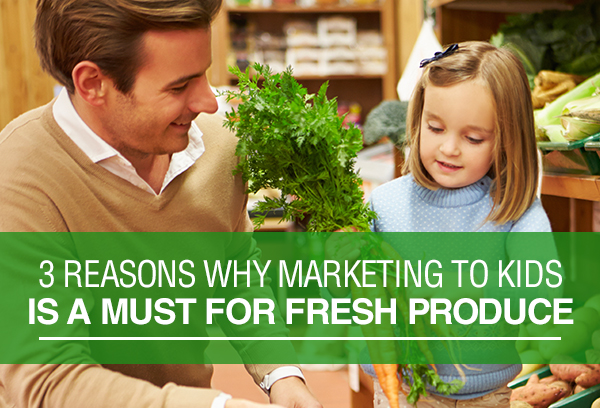 There is much debate on the topic of marketing to children, so much that national and international advocacy groups have taken up the cause of protecting children from the influence of targeted advertising. And while we at DMA recognize the negative consequences – both psychologically and physically – that unrestrained/unharnessed advertising to children can lead to, the reality is that for fresh produce companies, marketing to kids is actually an unparalleled opportunity to make a positive impact in the marketplace…and to your bottom line.
There is much debate on the topic of marketing to children, so much that national and international advocacy groups have taken up the cause of protecting children from the influence of targeted advertising. And while we at DMA recognize the negative consequences – both psychologically and physically – that unrestrained/unharnessed advertising to children can lead to, the reality is that for fresh produce companies, marketing to kids is actually an unparalleled opportunity to make a positive impact in the marketplace…and to your bottom line.
The folks at the Partnership for a Healthier America are likely to agree. Their recently announced #TeamFNV marketing campaign includes the tagline: “now shamelessly marketing to children,” and “prepare to be marketed to.” It’s true that the fresh produce industry has been fairly absent from the “food marketing table” thus far, but with the YMCA’s upcoming celebration of Healthy Kids Day® on Saturday, April 25, we’ve been considering the impact embracing this demographic could create for our industry. Imagine these positive possibilities when it comes to marketing fresh produce to children:
1. Marketing to children will help influence adult behaviors.
Children under 12 influence $500 billion in purchases each year.2
Did you read that?!? $500 billion dollars! And that data was from 2005.
So we know for a fact that children influence $500 billion (or more, 10 years later) a year in purchases AND we know that their influence lies partially in the area of food consumption. That means that children are influencing what foods are being stocked in pantries and refrigerators across the country – foods that are no doubt also consumed by the adults in their homes.
Our efforts to win the tummies and minds of kids will have an indirect impact on the food choices of parents and older siblings.
2. Children have buying power and can positively impact your sales.
Children under 14 spend about $40 billion annually3 and teens spend about $159 billion4.
Wow! Kids with very limited earning power actually control an impressive amount of shopping dollars – too significant to ignore. These kids have money in their pockets and are looking for ways to spend it. They are a unique buyer persona that should be given equal credence in our marketing plans and serious consideration in our sales goals. Our investment in educating children on the flavors and uses of fresh produce items for their betterment will simultaneously impact our bottom lines in a very positive way.
3. You have the power to rewrite history.
Food marketing directly to children has been a significant contributing factor to the childhood obesity epidemic.1
If marketing from junk food and fast food brands is directly linked to childhood obesity, then it also stands to reason that marketing from fresh food brands can have a direct impact on eating habits, but for the better. Think about it. This correlation proves that children can be persuaded to eat certain things through consistent and well-placed marketing efforts. Use this truth to your advantage and to the advantage of our nation’s children by educating them about healthier, tastier choices. There is really no good reason not to.
Convinced? If your brand is ready to start making efforts to market to the “under 18” demographic, consider getting started with involvement in Healthy Kids Day® in a few weeks. You can also look into philanthropic efforts like donating a salad bar to help mold children into future fruit & veg lovers!
1 Food Marketing to Children and Youth (2006). Institute of Medicine. Washington: The National Academies Press, p. 8.
2 Campbell, K. & Davis-Packard, K. (2000, September 18). How ads get kids to say I want it! Christian Science Monitor.
3 James McNeal quoted in BuyBabies. (2006, December 9). The Economist.
4 Tru. (2005, December 15). Tru projects teens will spend $159 Billion in 2005.











